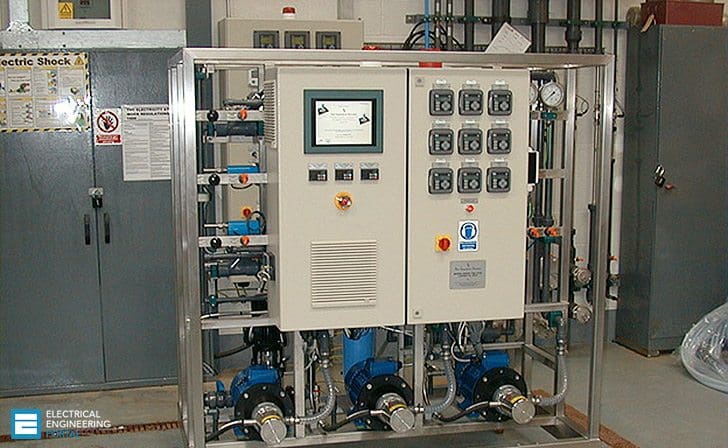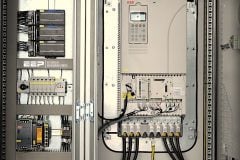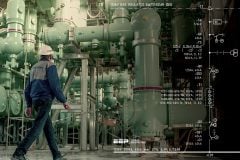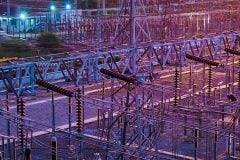
Selecting of a frequency converter for variable speed drives requires a lot of experience. If the experience is not available, it is often useful to visit either a reference plant with similar applications, or exhibitions or trade shows.
Checklist
The following is a brief checklist of points that should be considered:
- Details of the machine to be controlled
- Environmental details
- Mains
- Maintenance, operation, personnel
- Financial criteria
- Protective measures for operators/converter/motor
- Standards/regulations
- Environmental considerations
- Also important…
VLT Drives Applications (VIDEOS)
Some of the interesting applications done with Danfoss VLT drives:
- VLT drives in large desalination plant
- VLT drives control cooling tower fans
- VLT control optimizes spindle speed in Indian textile factory
- VLT frequency converters drive bagage handling system
- VLT Drives Save 78% Energy in Chester Zoo
1. Details of the machine to be controlled
- Required plant/machine characteristics
- Torque characteristics, stalling torque, acceleration torque
- Speed control range, cooling
- Power consumption of the converter and the motor
- Operating quadrants
- Slip compensation (dynamic)
- Required ramp-up and ramp-down times
- Required braking times, brake operating time
- Direct drives, gears, transmission components, moment of mass inertia
- Synchronisation with other drives
- Operating time, controls
- Computer linkage, interfaces, visualisation
- Design and protection type
- Possibility of integrating decentral intelligence in the frequency converter
2. Environmental details
- Installation height, ambient temperature
- Cooling requirements, cooling options
- Climatic conditions, such as humidity, water, dirt, dust, gas-es
- Special regulations, e.g. for mining, the chemical industry, the ship building industry, food technology
- Acoustic noise
3. Mains
- Mains voltage, voltage fluctuations
- Mains performance
- Mains frequency fluctuations
- Mains interference
- Short-circuit and overvoltage protection
- Mains drop-out
4. Maintenance, operation, personnel
- Training and instruction of operators
- Maintenance
- Spare parts/spare units
5. Financial criteria
- Purchase costs (components)
- Space requirement, integrated installation, design
- Installation costs
- Commissioning of the system
- Set-up costs
- Operating costs
- Efficiency of the system (frequency converter and machine)
- Reactive power requirement and compensation for harmonic loads
- Product lifetime
6. Protective measures for operators/converter/motor
- Galvanic isolation in accordance with PELV
- Phase drop-out
- Switching at the converter output
- Earth and short-circuit protection
- Motor coils to reduce voltage rise times
- Electronic thermal monitoring and connection of thermistors
7. Standards/regulations
- National DIN, BS, UL, CSA, VDE, European EN
- International IEC, CE, etc.
8. Environmental considerations
- Ability to recycle the product
- Manufacturing practice
- Energy saving factors
Also important…
Using this checklist a frequency converter can be selected which covers most of the items as standard, but you should also double check whether:
- The converter has mains or intermediate circuit chokes in order to greatly reduce mains interference
- A RFI filter for class A or B is standard or has to be purchased separately
- Motor derating is required if a frequency converter is used
- The converter itself is protected against earth and short-circuit
- The converter reacts adequately in a fault situation.
VLT Drives Applications (VIDEOS)
1. VLT drives in large desalination plant
Cant see this video? Click here to watch it on Youtube.
2. VLT drives control cooling tower fans
Cant see this video? Click here to watch it on Youtube.
3. VLT control optimizes spindle speed in Indian textile factory
Cant see this video? Click here to watch it on Youtube.
4. LT frequency converters drive bagage handling system
Cant see this video? Click here to watch it on Youtube.
5. LT Drives Save 78% Energy in Chester Zoo
Cant see this video? Click here to watch it on Youtube.
Resource: Fact Worth Knowing About Frequency Converters – Danfoss











Hello,
Nice work here. Is there any partparticular expreexpression for sizing speed drive?
Very , very useful ; I’ve worked with variable speed drives, so I know the subject ; Many thanks for your effort !
why not make a downloadable version of the article in the form of pdf file so it can be read later
thanks for the effort
Hi Tarekdia,
You can make PDF of any technical article using link ‘Get PDF’ at the top of article, below title on the right.
You can optimize your PDF, set font size and remove images as well.